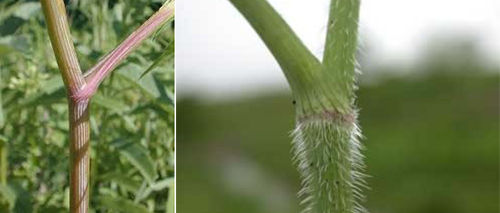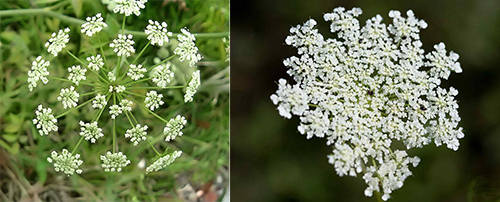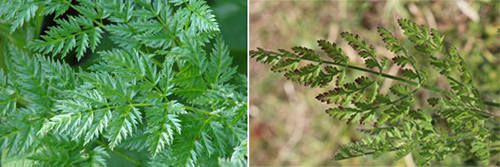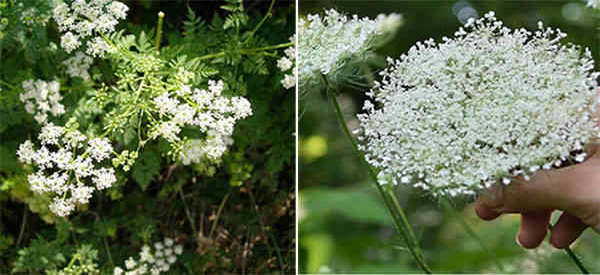The edible and healing Queen Anne’s Lace is a member of the same family as the poisonous Hemlock and the plants look similar. You should always be sure of your identification before using a plant, but in this case the stakes are very high. We will go through the differences here to help you identify both plants. Poison hemlock vs Queen Anne’s lace is a delicate topic we need to be serious with.
Use Caution When Identifying Plants
Since all parts of water hemlock are poisonous, please use caution when handling the plant for identification and do not harvest any plant until it is definitively identified. I wear gloves when handling plants such as hemlock for identification or other purposes.
Contrary to some beliefs, hemlock does not produce a contact rash or irritation. The poison is active when ingested, but it can also be transferred from your hands to your mouth or eyes and can be absorbed through cuts or wounds. Even tiny amounts can be toxic.
Look at the Flowers
Both plants have white flowers that bloom in umbrella like clusters called an umbrel. The Queen Anne’s lace flowers clusters are arranged flat across the top while the Hemlock flowers are more spread out with more space between the smaller flower clusters.
One way to absolutely identify Queen Anne’s lace is to find the single purple or red flower in the center of the umbrel. If the flower is present, it is definitely Queen Anne’s lace. However, absence of the flower does not mean that the plant is hemlock. Some varieties of Queen Anne’s lace also lack the center purple flower.
Related: 30 Most Popular Herbs for Natural Medicine
Compare All Differences
The two plants look very similar and can be mistaken. I am giving you a chart below with comparisons between the plants, but I recommend that you not rely on any one characteristic and do not rely on memory unless you are skilled in telling the plants apart. A mistake can be deadly.
The healing Queen Anne’s lace plant is hairy. It has hair on the undersides of the leaves and on the flowering stem. Its flowers are arranged in a tight, flat topped umbrel which grows at the end of a solid green stem.
Hemlock grows almost twice as tall as Queen Anne’s lace, but this alone is not enough to distinguish the plants. Hemlock flowers grow at the end of a hollow stem which is often splotched or spotted with dark red or purple spots. The umbrel is more rounded in shape and more open.
Comparison Points for Hemlock to Queen Anne’s Lace
#1. Compare plant height. Hemlock grows to be 6 to 10 feet tall, while Queen Anne’s lace is only 3 to 6 feet in height.
#2. Compare the flower stem. Hemlock has a smooth, thick stem with red or purple splotches of varying sizes. Hemlock stems can be completely purple or have purple stripes. Queen Anne’s flower stems are thinner and green or green with long red stripes.
#3. Hemlock flower stems are smooth on the outside and hollow on the inside. Queen Anne’s lace flower stems are more solid and have short hairs that should be visible in a close look and feel fuzzy to the touch. #4. Hemlock flower stems often have a white powdery coating and Queen Anne’s lace stems do not.
#4. Hemlock flower stems often have a white powdery coating and Queen Anne’s lace stems do not.
#5. Hemlock flowers are more spread out with more space between the smaller flower clusters while Queen Anne’s lace flowers form a tighter pattern with less space between the flowers.
Hemlock umbrels are rounded while Queen Anne’s lace umbrels are flat across the top. #6. Hemlock umbrels are a collection of green or white petals gathered in an umbrella shape. Umbrels are 2 to 4 inches across. Queen Anne’s lace umbrels are 3 to 4 inches wide and may be pink in bud and white when in bloom.
#6. Hemlock umbrels are a collection of green or white petals gathered in an umbrella shape. Umbrels are 2 to 4 inches across. Queen Anne’s lace umbrels are 3 to 4 inches wide and may be pink in bud and white when in bloom.
#7. Queen Anne’s lace sometimes has a single reddish or purple flower in the center of each umbrel. Locating this single red or purple flower is definitive for Queen Anne’s Lace, but not all varieties have this sign. Hemlock never has this blood colored flower.
#8. Dried hemlock umbrels retain their original shape while Queen Anne’s lace umbrels curl into a bird’s nest shape when dry.
#9. Hemlock leaves are finely divided and lacy. They are tripinnate and alternate in a pinate pattern. Serrations are sharply pointed. Queen Anne’s Lace leaflets are lanceolate and serrated. Each is 2 to 4 inches in length with serrations that are more rounded at the tips. The lower side of the leaves is slightly hairy. #10. Compare the scent of the plant. Hemlock has an unpleasant odor while Queen Anne’s lace has a pleasant scent that is much like carrots.
#10. Compare the scent of the plant. Hemlock has an unpleasant odor while Queen Anne’s lace has a pleasant scent that is much like carrots.
#11. Compare the roots. Hemlock roots are thickened tubers that grow deeper and spread more than the Queen Anne’s lace tap root. Hemlock roots produce an oily juice that turns reddish brown on exposure to air. Queen Anne’s Lace root is also known as wild carrot and is shaped like a thin carrot. It usually is a single tap root.
Related: How Cherokees Used Trees of Southern Appalachia for Food, Medicine, and Craft
Helpful Ways to Remember the Plants
Over the years, foragers and herbalists have created stories to help them remember which plant is healing and which is deadly. Here are two such memory devices:
Legend has it that while Queen Anne was sewing a piece of lace, she pricked her finger and a single drop of blood fell into the center of the flowers, giving them the single red or purple flower in the center of each umbrel. The presence of this blood colored flower is a positive identification for Queen Anne’s Lace and it’s healing properties.
Another way to remember the plant is to think of Queen Anne lifting her skirt and showing off her hairy legs. She would surely never have done such a thing, but Queen Anne’s lace has hairy stems and the image helps you remember the fact.
Positive identification is mandatory when harvesting any plant, but especially when dealing with a plant like hemlock. Even one small taste is enough to kill you, so no mistakes are allowed. Once you know the plant well, you will have no problem identifying them. Meanwhile, please take the time to compare all the identifying characteristics. I hope this article helps.
You may also like:
 10 Edible Roots That Kept This Hermit Monk Alive
10 Edible Roots That Kept This Hermit Monk Alive
This Bug Will Kill Most Americans During The Next Crisis (Video)
Medicinal Uses for Activated Charcoal






















Finally a useful article. This place has become an echo chamber.
I noticed a discrepancy in the description between hemlock and queen Anne’s lace. Under the heading “LOOK AT THE FLOWER” In the first paragraph, last sentence, the flower description is the opposite of what is described later in the article under #5; just above the photo, this description appears to be correct.
I enjoy and appreciate all of your info articles. They are very informative. Thank you for all your efforts.
Thank you so much for pointing this out. I modified it.
The umbrella shape of Queen Anne’s lace is flat-topped and has a single purplish/red flower in the center of the umbel the vast majority of the time
Confusing at the beginning (par 4) you state hemlock flowers are flat across the top, and QA is rounded. Then later it is the opposite. Please clarify.
“The hemlock flower clusters are arranged flat across the top while the Queen Anne’s lace flowers have a more rounded or umbrella shape to the cluster.”
Then further down: “Hemlock umbrels are rounded while Queen Anne’s lace umbrels are flat across the top”. So which is it? It can’t be both. These statements are contradictory!!.
Which is it? Flat or rounded. You give two different descriptions.
This article could get someone seriously hurt or killed. Early in, it says, “The hemlock flower clusters are arranged flat across the top while the Queen Anne’s lace flowers have a more rounded or umbrella shape to the cluster.” Later it says, “Hemlock umbrels are rounded while Queen Anne’s lace umbrels are flat across the top.” So which is which?
There are 2 sentences in this article that may cause A LOT of confusion:
+ The hemlock flower clusters are arranged flat across the top
+ Queen Anne’s lace umbrels are flat across the top.
BOTH ARE NOT FLAT ACROSS THE TOP!!!
So which is correct? When dealing with such a deadly plant this SHOULD be made much more clear!!!!!
You contradicted yourself.
In the 4th paragraph, you write “The hemlock flower clusters are arranged flat across the top while the Queen Anne’s lace flowers have a more rounded or umbrella shape to the cluster.”
And then in ID tip number 5, you write “Hemlock umbrels are rounded while Queen Anne’s lace umbrels are flat across the top.”
Your tip number 5 is correct, but you might want to correct the article before someone hurts themselves.
The hemlock flower clusters are arranged flat across the top while the Queen Anne’s lace flowers have a more rounded or umbrella shape to the cluster.
Hemlock umbrels are rounded while Queen Anne’s lace umbrels are flat across the top.
These are two comments you make in the article. And to me it seems they contradict themselves. Which one os correct.
I really enjoyed this informative article. I live in a forested/meadow area in Colorado, and am beginning to learn about botany. Thanks so much!
Confusing data. See paragraph after “Look At The Flowers”. I quit reading once I noticed that.
Look at the Flowers
Both plants have white flowers that bloom in umbrella like clusters called an umbrel. The hemlock flower clusters are arranged flat across the top while the Queen Anne’s lace flowers have a more rounded or umbrella shape to the cluster.
Then look at Comparison Point #5:
#5. Hemlock flowers are more spread out with more space between the smaller flower clusters while Queen Anne’s lace flowers form a tighter pattern with less space between the flowers.
Hemlock umbrels are rounded while Queen Anne’s lace umbrels are flat across the top.
This article contradicts itself. At one point is stated “The hemlock flower clusters are arranged flat across the top while the Queen Anne’s lace flowers have a more rounded or umbrella shape to the cluster.” But later it says “Hemlock umbrels are rounded while Queen Anne’s lace umbrels are flat across the top.”
Which is correct?
1. The hemlock flower clusters are arranged flat across the top while the Queen Anne’s lace flowers have a more rounded or umbrella shape to the cluster
2. Hemlock umbrels are rounded while Queen Anne’s lace umbrels are flat across the top.
I’m confused ?
In the fourth paragraph you state the shape of the flowers as follows: “The hemlock flower clusters are arranged flat across the top while the Queen Anne’s lace flowers have a more rounded or umbrella shape to the cluster.” Then, and point # 5 we contradict that information with the following, “Hemlock umbrels are rounded while Queen Anne’s lace umbrels are flat across the top.” Therefore, I don’t feel like I can trust the information in this article.
Is there a problem with Comparison # 5 referencing the umbels being flat on one and rounded on the other ??
As I read it, it seems to disagree with the statement at the top of the article. If I am wrong no problem, but this is too dangerous to humans to have a mistake.
Hi! Would you please clarify:
‘Both plants have white flowers that bloom in umbrella like clusters called an umbrel. The hemlock flower clusters are arranged flat across the top while the Queen Anne’s lace flowers have a more rounded or umbrella shape to the cluster.’
‘Hemlock umbrels are rounded while Queen Anne’s lace umbrels are flat across the top.’
Sorry, I’m a little confused. Would you please clarify which one is flat across the top? Thank you. 🙂
Based on this article I plan on avoiding all flowers that remotely resemble all of the above.
These are definitely plants that you do not want to get confused. According to Health Line, there is no cure for hemlock poisoning. For convenience to the link: https://www.healthline.com/health/hemlock-poisoning#outlook
Depending on your moral standard after SHTF, hemlock would make a MAD (mutually assured destruction) weapon. Include it in the stores that you have set aside for sacrifice, and you may cause someone serious pain or death. Likewise, you could make a spray to possibly get into someone’s airway, eyes, or open sores.
I hope we, as a nation or a group, NEVER have to face a situation in which we are willing to kill someone simply for being hungry. I would hope that my compassion will continue into the nastiness that is yet to come, but as so many have pointed out, my family’s survival comes first. Will I kill, or will I try to earn an ally? That is something that I will be wrestling with for a long time.
I have land, but do not have enough food stored for long term survival. I will be relying on my skills to survive. I would actually prefer to have more stores, but isolation also makes an easy target. Even if I don’t have big bands of marauders roaming the countryside, it is the obscure loner that worries me.
I have read some of the statements about lone wolf or community participation. Some lone wolfs here have to right attitude of just wanting to survive and not have others trying to take from them; while some have the attitude that if their skills aren’t good enough, they will take what they want, no matter who is standing in their way.
I am old, I am lazy, and I know that I will have to answer for my life. The reason I say I am lazy is, I don’t want to put forth the effort to feed the masses. I will provide for me and mine, but I don’t want to give to those who won’t do for themselves. I also don’t want to have to fight someone, and then haul back what little I may gain. And, with my earlier statement about MAD, how can I be sure the food I get isn’t tainted in some way?
Queen Anne or Hemlock, Giant Hogweed or Cow Parsnip, or other plants that have to be carefully identified should all have a color identification guide that you are familiar with and is easily accessible. What good is prepping for, if you are only going to kill yourself or your family because you made a mistake?
when gets completely right let me know for sure.
This is confusing. After reading it, I still don’t know which is Hemlock and which is Queen Anne’s Lace. The word on the PHOTO ITSELF, or under it, would help!
Thank you for your kindness in attempting to educate us. I believe you made it quite possible to distinguish between Hemlock and Queen Ann’s Lace. I’ll be watching for more.
What about the smell? I can’t stand the smell of Queen Annes Lace, does the Hemlock smell similar?
Water Hemlock is a different plant altogether. I have always referred to the one you are talking about as “Poison Hemlock”.
No real comment. I just recently got a spark of interest in plants and their good uses.
Everyone sure is quick to judge, if you read the comments, the error was rectified early on by the author after a reader pointed it out. I realize what a serious error it was. However, I found the article to be extremely informative.
Goodness, get a good plant book with color photos, the plants don’t look that much alike in real life and you can easily learn the difference.
If you are in the wild and out of food you don’t need to waste your time on the parsley family, or nightshades or greens, you need to learn the plants in your area that provide enough calories to make the effort of gathering them worthwhile like cattails,duck potato (sagittaria), yellow nut sedge (cyperus), and prairie potato (psoralea). And I’ve read some great posts on this site on eating acorns, I had no idea…
I’m glad I already knew what Queen Anne’s Lace looks like!
Sheeee!
Perhaps some proof reading before posting is in order.
The best descriptions I have seen are in Samuel Thayer’s wild foraging books where he clearly shows the difference between hemlocks and similar edibles. Anyone who is interested in foraging for wild edibles can’t go wrong with his books. There are 3.
What is the name of his books?
I thought hemlock was a large type of evergreen tree, looks similar to a spruce, but tinier needles. They grow near where I live in some forest land along a river. Never heard of it as a flowering weed. We have tons of Queen Anne’s lace here in Michigan, has a black tiny floret in the center usually. We also call them wild carrots here, smell like carrots, roots taste like a strong parsnip, carrot like. Will pay more attention & see if I notice this hemlock weed.
Claude, if you would write a complete book about “Plant Foraging & Identification” – Please do that… My request… If that would be possible in the near future – You’ve got one supporter of your work here who will buy your book as soon as it comes out of the bookstores or online…
thank you so much for this article. Saw some in the woods and wondered if it was the good or bad plant. Now I can go back and look for the hairy stems to see if it’s Queen Anne’s Lace.